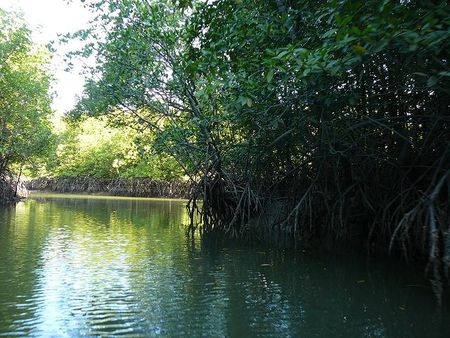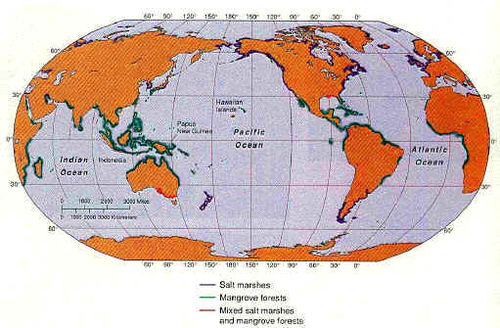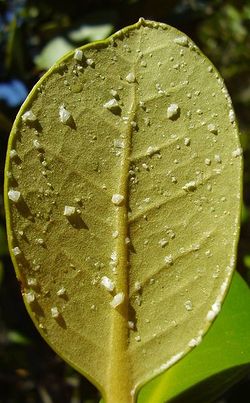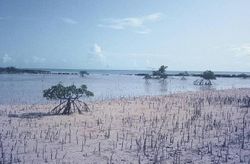Mangroves
This article describes the habitat of the Mangrove forests. It is one of the sub-categories within the section dealing with biodiversity of marine habitats and ecosystems. It gives an overview about the characteristics, distribution, biota, functioning and adaptation to general problems the organisms are facing with. A short discussion about the threats is also present.
Contents
Introduction
Mangroves are the only trees that are capable of thriving in salt water. They form unique intertidal forests at the edge of land and sea. They are represented on all continents with tropical and subtropical coasts, i.e. North and South America, Africa and Middle-East, Asia and Oceania (incl. Australia). [1]
Mangrove forests or mangals are a type of intertidal wetland ecosystems. The word mangrove is derived from the Portugese word mangue which means “tree” and the English word grove which is used for trees and shrubs that are found in shallow, sandy or muddy areas. [2] They replace Salt Marshes in tropical and subtropical regions.
They are salt-tolerant forested wetlands at the sea-land interface which forms the link between the terrestrial landscapes and the marine environment. The dominant plants are several species of mangrove (for a species overview, check the Mangrove Species Database [3]).
Mangroves are woody trees and shrubs with a thick, partially exposed network of roots that grow down from the branches into the water and sediment. They occur where there is little wave action and where sediments accumulate. These fine grained (muddy and sandy) sediments lack oxygen. [4]
They are frequently associated with saline lagoons and are regularly found on protected sides of islands, atolls and tropical estuaries. [5]

Distribution
The distribution, density and species composition are determined by the water and air temperatures during the winter, exposure to wave action and tidal currents, the range of the tide, the type of sediment and the chemistry of the seawater. The most highly developed and most species rich mangals are found in Malaysia and Indonesia. Over the world, 54-70 species (for a species overview, check the Mangrove Species Database [7])(and hybrids) in 20-27 genera and 16-19 families are found. [8]
They are almost exclusively tropical, but are also seen in the subtropics. Mangroves are intolerant of frost, but can tolerate air temperatures as low as 5°C. They are most closely correlated with the seawater temperature. The 20°C isotherm in the winter is a good indicator for the limit of distribution. The number of species tends to decrease with the distance from the equator. In the southern hemisphere, ranges extend further south on the eastern margins of land masses than on the western. This is because of the pattern of warm and cold ocean currents. But local anomalies of current and temperature or the local evolution can create local changes. [9] [10]

Requirements for development
Mangroves have several requirements to develop.
- They need average temperatures of the coldest month higher than 20°C. The
seasonal temperature range should not exceed 5°C. They can tolerate temperatures of 5°C, but the development will be affected. They are not resistant to freezing.
- In general they need a fine-grained substrate. But there could be some exceptions. This is the case in Papua New Guinea and Kenya, where the mangroves grow on corals.
- The shores must be free of strong wave action and tidal currents.
- They need salt water. They are facultative halophytes.
- They need a large tidal range. This causes limited erosion and deposition of sediments.
Due to these processes, a well-marked zonation is seen. Each of the zones is dominated by a different mangrove species and associated fauna and flora. Red mangroves (Rhizophora) are usually found the closest to the edge of the water, where the greatest degree of tidal flooding occurs. More landwards are the black mangroves (Avicennia). These areas receive only shallow flooding during high tide. The upper limit of the mangroves is occupied with white mangroves and buttonwoods. The buttonwoods are not really a mangrove species, but are a transition species between the mangrove and the terrestrial vegetation.
Functioning and adaptations
The mangroves have several functions and adaptations to a life in an intertidal ecosystem. They need to conquer some problems to be resistant to the environment. The first problem is that mangrove trees are freshwater riverine trees. They grow in an environment whose salinity ranges between that of freshwater and seawater. For this reason, they have to take up water against the osmotic pressure. To overcome the negative osmotic pressure, they generate a negative hydrostatic pressure (by transpiration processes). They developed a mechanism to exclude salt by the roots or leaves. In this way, they are tolerant for saline conditions. Even with exclusion of most of the salts, concentration of chloride and sodium ions in the tissue is higher than other plants. This high concentration can inhibit many enzymes. To protect the enzymes, the salt is stored in vacuoles. The high cation concentrations are balanced by high non-ionic solutes in the cytoplasm. Several mangrove species deposit sodium and chloride in the bark of stems and roots. Other species deposit salt in senescent leaves, which later fall off the tree. Salt glands on the leaves also exclude salt. This can be seen as salt crystals. The lower surface of the leave is highly covered with hairs to raise the secreted droplets of salty water away from the leaf surface. This prevents osmotic withdrawal of water from the tissue. They also restrict the opening of their stomata (only on the lower surface of the leaf), have a tick cuticle with a waxy layer, and orientate their leaves to avoid the burning sun. This also reduces evaporation. Because salt tolerance is costly, a greater relative root mass is needed to recover the demand for water. When it rains, drop roots, descending from the branches, absorb the freshwater that runs down from the stem through a special superficial layer. In this way, no high-energy inverse osmosis is needed.
References
- ↑ http://www.vliz.be/vmdcdata/mangroves
- ↑ Karleskint G. 1998. Introduction to marine biology. Harcourt Brace College Publishers. p.378
- ↑ http://www.vliz.be/vmdcdata/mangroves
- ↑ Hogarth P.J. 1999. The biology of mangroves. Oxford University Press. p.228
- ↑ Karleskint G. 1998. Introduction to marine biology. Harcourt Brace College Publishers. p.378
- ↑ http://teqje.web-log.nl
- ↑ http://www.vliz.be/vmdcdata/mangroves
- ↑ Bertness M.D. Gaines S.D. Hay M.E. 2001. Marine Community Ecology. Sinauer Associates, Inc. p. 550
- ↑ Pinet P.R. 1998.Invitation to Oceanography. Jones and Barlett Publishers. p. 508
- ↑ Hogarth P.J. 1999. The biology of mangroves. Oxford University Press. p.228
- ↑ Richard Parker
Please note that others may also have edited the contents of this article.
|

